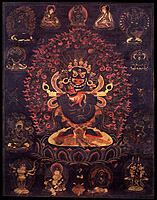
|
Mahakala Gur gyi Gonpo (painting no. 649)
|

View Larger Image |
||||||||||||
|
Panjarnatha Vajra Mahakala (Tibetan: dor je nag po chen po, gur gyi gon po, English: The Great Vajra Black One - Lord of the Pavilion). For the central figure - "the great Vajra Mahakala blazes, with one face, two hands, holding in the right a curved knife and in the left a skullcup filled with blood, held above and below the heart. Across the middle of the two forearms is the 'Gandhi of Emanation.' With three eyes, bared fangs, yellow hair flowing upward, [he has] a crown of five dry human skulls and a necklace of fifty wet - blood dripping. Adorned with six bone ornaments and snakes, having a lower garment of tiger skin, flowing with pendants and streamers of various silks, in a posture dwarfish and thick [he] stands above a corpse." (Konchog Lhundrup 1497-1557). At the top center is the primordial buddha Vajradhara with one face and two hands holding a vajra and bell. To the left is Sachen Kunga Nyingpo (1092-1158). To the right is a lama wearing the robes of a monk and a pandita hat with the lappets folded over the top in a Sakya style. At the left corner is Vajra Bhairava, in Heruka form, with one buffalo face and two hands holding a curved knife and skullcup to the heart; surrounded by flames and standing atop a buffalo. Below that is another wrathful figure with a small warrior figure again below that. At the top right is the tutelary deity Shri Hevajra, with multiple faces and hands embracing the consort Vajra Nairatmya. Below that is Ekajati, the mother of all Mahakalas, with one face and two hands holding a vase. Below that is the small figure of a monk carrying a staff and wearing a hat. To the lower right is Mahakali with one face and four hands riding a mule. To the lower left is the Brahmarupa Mahakala holding a skullcup and shin-bone horn in the left hand, seated in a relaxed posture. Along the bottom from the left is the wealth deity White Mahakala with six hands standing with the legs straight. Following that is yellow Jambhala, in the form of a yaksha, holding a bijapuraka fruit in the right hand and a mongoose in the left; followed by black Jambhala, naked, holding a skullcup and mongoose, in a standing posture. At the bottom right is Citipati, Lords of the Charnel Ground Pyre in the appearance of two skeletons, holding bone sticks and entwined in dance. Panjarnatha Mahakala is the main protector of the Sakya School. Arising from the Vajrapanjara Tantra, he along with the Brahmarupa Mahakala, associated with the Guhyasamaja Tantra, are known as the 'Greater and Lesser Mahakalas' of the Sakya School (Tib.: gon po che chung). Panjarnatha Eight Deity Lineage: Vajradhara, Dakini Vajrapanjara, Acarya Brahmin Vararuci, Norbu Lingka Dewa'i Dorje, Shraddhakara Varman, Lochen Rinchen Zangpo, Drag Tengpa Yontan Tsultrim, Mal Lotsawa Lodro Dragpa, Sachen Kunga Nyingpo, etc. The method of painting is called 'black scroll' (Tib.: nag thang) - gold outline on a black background with various colours used for fill. This style is generally reserved for wrathful deities. J.Watt 7-98
|
|||||||||||||
Photographed Image Copyright © 1999 Shelley & Donald Rubin Foundation
|
|
| |
Next Image |